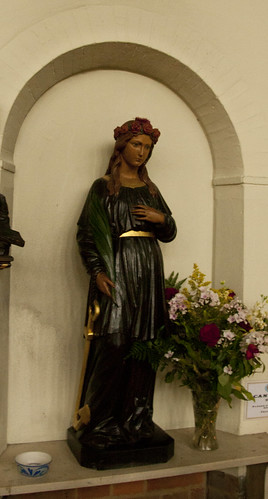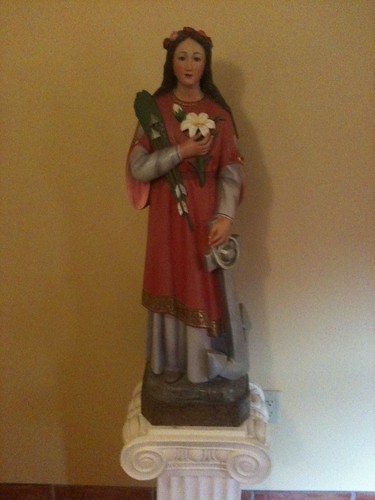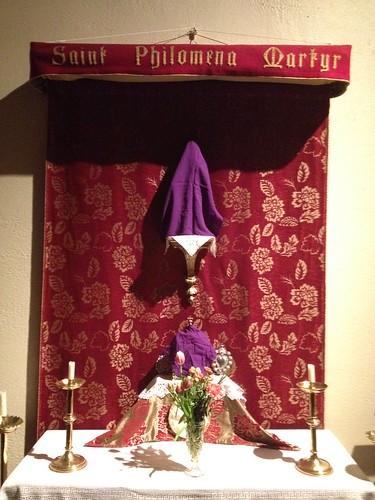 |
| A devotional image of St Philomena, in Our Lady of Willesden, London |
It seems counter-productive for the church in question to include St Philomena in the title of dedication. On 14th February 1961, in a sweepout of "saints" whose holiness or even very existinece was dubious, the Act Apostolicae Sedis generously allowed that they could remain in local liturgical calendars, but not in the unversal one, except for St Philomena - she was to be "expunged from all calendars whatsoever" (1961, p174). So unless the church concerned intends to treat that instruction with contempt, they have adopted a subsidiary title which they can never celebrate.
He must be chewing the carpet now that the shrine to St Philomena in the church has been progressively restored, and, two days after her traditional feast day, the Lottery Fund has given a large sum of money for the restoration of the church. St Philomena has been at it again.
The fact is that this was always the dedication of the church: SS Peter & Paul and St Philomena. And while we may argue about the merits of the changes to the calendar made in 1961, devotion to, the cult of, St Philomena, has never been suppressed. It follows that it is permissible to celebrate Mass in her honour on any free day.
 |
| St Philomena in the Seminary of Our Lady of Guadaloupe, of the Fraternity of St Peter in the USA |
Not only that, but the authorities have continued to distribute her relics for the establishment of shrines in her honour. The National Shrine in the USA got one in 1991, and another in 1994. The international shrine in Italy at Mugnano also still exists.
The church since the Council has often seemed to generate confusion, with radicals promoting their agenda on the basis of legal actions which don't quite manage to do what they claim they do. This is no exception. St Philomena enrages modernists because, apart from the fact of her bones being found in the catacombs, the basis of her cult is supernatural, not historical. Although nothing of substance is known about her, she became popular because of the miracles she worked in response to prayer, notably for St Jean Vianney, who himself built a shrine to her in his church. She gives the lie to the notion that the saints are there just for imitation, not for intercession, and that facts of history must be separated from matters of faith. She is, truly, a saint for our times.
 |
| The Shrine of St Philomena in SS Peter & Paul in the Wirral, last time I was there: passion tide, when the images were all veiled. |
As a historical footnote, the liturgical reformer Bugninni wanted to get rid of the Roman Canon because he thought some of the saints mentioned are historically dubious. Well, they are still there - even in the Novus Ordo. But he is entering a well-deserved oblivion.
As a Loftus, I cringe every time Basils name comes up. Every family tree has at least one rotten root.
ReplyDeleteOh dear, I am sorry.
DeleteStill, I share a surname with George Bernard Shaw... No relation!
Thank you St Philomena.
ReplyDeleteI was fortunate to be at the Mass last Sunday and take part in the procession and devotions to St Philomena post Mass. It was beautiful as is the new altar of St Philomena which has now replaced that depicted in Dr. Shaw's post.
ReplyDelete